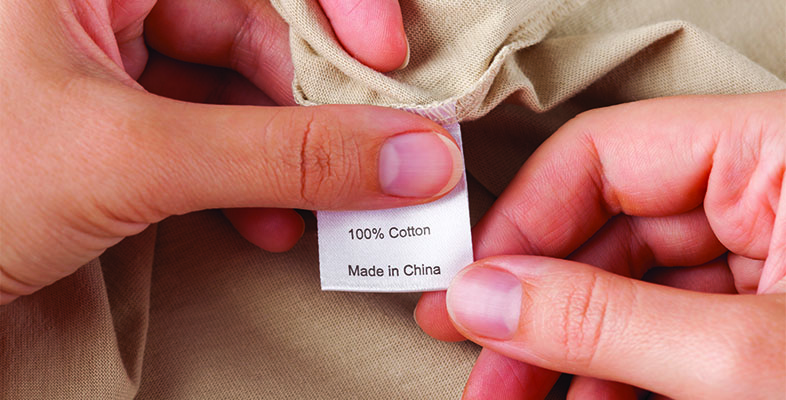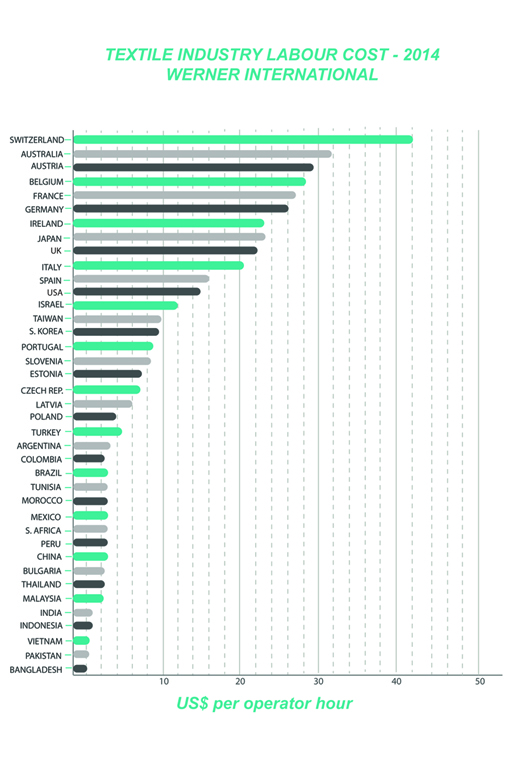3.3 Labour costs
Figure 7 shows a comparison of the labour costs in the textile industry across different countries.
The data shown in Figure 7 is produced by gathering information from the textile industry through the use of questionnaires. The labour costs are for the primary textile industry: spinning, weaving, dyeing and finishing but cutting and sewing are not included. Figure 7 is another example of a bar chart. It is similar to earlier examples that we have looked at but differs in that the bars run horizontally rather than vertically. In the same way as before you can read the values for each country from the end of the bar, this time to the horizontal, or x axis.
Activity 22
Which countries shown in Figure 7 experience the lowest labour costs in the textile industry? Compare this to the highest labour costs in the table.
Answer
The lowest labour costs are in Bangladesh. Other countries with low labour costs are India, Indonesia, Vietnam and Pakistan. The cost of labour in Bangladesh is $0.62 per hour. This is only 3.5% of the cost in the US $17.71 and only 1.25% of the Swiss rate of $51.36 per hour.
For production techniques which are labour intensive requiring a large number of workers countries with lower labour costs are attractive for firms and this is why large parts of the life of the t-shirt is spent in countries such as Bangladesh, Vietnam and India where labour costs are low.
Globalisation has allowed greater opportunities for countries like these to reap the benefits of the low wage costs. Many foreign firms and retailers in Europe and the USA outsource their production to these countries. Indeed, if you check the tag of your T-shirt, most likely that will show that is ‘made in Bangladesh’. This has led to economic changes in many low wage countries. Developing countries such as Bangladesh have benefitted greatly from the garment making process since their involvement from the late 1970s.
RMG is the mainstay of the Bangladesh economy which contributes 83.5% of the export earnings from production by 3,856 factories employing 3.6m workers, of which 85% are women.
The growth in the Bangladesh clothing industry has had beneficial effects on the economy as a whole with the economy growing by almost 6% per annum since the mid-1990s. Masum (2016). While the economy is growing poverty rates are falling:
Bangladesh’s poverty rate reduced to 24.3% at the end of the last year from 31.55% in previous years, according to a survey report.
However, despite these benefits there has also been some negative impact. The low wages are a source of competitive advantage (definition) but they are also detrimental to the welfare of the workers in these countries. Low wages often correspond to low living standards for the workers and their families. Many workers are obliged to work long hours, without or little rights such as social protection, pensions, or sick leave. The low wages also mean that workers find it difficult to cover basic education expenses such as books etc and so many children leave education. As a result the literacy rate in Bangladesh has traditionally been low, remaining below 50% in 2011 (Countryeconomy.com, 2019). However there is evidence that this has improved significantly over recent years. Unesco statistics suggest that the literacy rate has increased to more than 72% in 2016 (UIS, cited in Dhaka Tribune, 2018). The low levels of education and training make it difficult for the work force to increase the level of skills that they have.
Due to the competition for textile contracts among firms in different developing countries, but also because of the weak power of trade unions workers have low bargaining power to negotiate better working conditions. The governments are also keen to keep the contracts and so have no incentive to change the conditions in the labour market. There are concerns about working conditions in the factories with low profit margins often leading to poor working conditions and safety standards. The Rana Plaza factory collapse in 2013 saw 1134 people die. This lead to the Bangladesh Accord aimed at improving working conditions. The governments in these countries are also implementing minimum wage legislation and legislation aimed to reduce the use of child labour, although poor implementation of these rules by the firms is often an issue. But as working conditions in Bangladesh improve, their labour costs are increasing and many firms are choosing to move their production to countries which have cheaper labour. Ethiopia and other sub-Saharan countries for instance.
Instead, as you may have noticed in Activity 14 the countries involved at the high value added stage of retail are largely developed countries, mostly US and Europe, so they reap the value in this sector. According to the Rieple and Singh (2010) data the value added in the final stage of the life of the t-shirt adds approximately 80% of the overall value of the t-shirt. This is more than that estimated in Norfield (2012) who calculates that out of a €4.16 t-shirt €2.66 is added to the value of a €1.35 t-shirt after it leaves the Bangladesh factory. At this stage there are costs of transport, shop floor rental, retail staff, sales and marketing. In this analysis the profit of one t-shirt is 60c, more than half the daily pay of a seamstress in Bangladesh who after overtime receives €1.18 per day, Uchatius (2010). These countries tend to reap the biggest share of the benefit from the value chain of the T-shirt because they are endowed with higher human capital (technical skills, education), technology, logistics (i.e. transport) and information. And they are often the countries who decide where to invest to supply their t-shirts.

